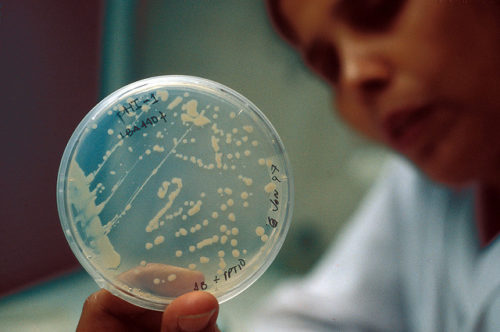
by Louise Sales
Last week US biohacker Ellen Jorgensen toured Australia encouraging members of the public to genetically modify microbes prompting the GM Free Australia Alliance to call for a ban on the genetic engineering of microbes outside contained and certified laboratory facilities.
Biohacking generally means genetically modifying a bacteria, yeast, plant or animal to change its function or physical characteristics. Whilst such tinkering currently appears to be legal in Australia, the development of new genetic modification (GM) techniques such as CRISPR [i] have seriously upped the stakes of such experimentation – posing major potential risks to human health and the environment.
Workers in commercial biotechnology labs have already suffered serious health impacts from exposure to genetically modified microbes, [ii] including an Agriculture Department scientist who spent a month in a coma after being infected by the E. coli bacteria her colleagues were experimenting with.
“If you look at pathogenic organisms in nature, they often differ from their nonpathogenic counterparts by very tiny modifications ” Stuart Newman, Professor of Cell Biology and Anatomy at New York Medical College, told Digital Trends. For example, the bacteria that causes the deadly diphtheria infection “was a benign resident of the respiratory system,” he said. “But at some point during evolution…it picked up a protein…which allowed the Bacillus to interact with the human organism and cause horrendous illness.”
Earlier this year the US Director of National Intelligence, James Clapper, added gene editing techniques such as CRISPR to a list of threats posed by “weapons of mass destruction and proliferation” in the annual worldwide threat assessment report of the U.S. intelligence community. “Given the broad distribution, low cost, and accelerated pace of development of this dual-use technology, its deliberate or unintentional misuse might lead to far-reaching economic and national security implications,” the report concluded. [iii]
In 2001, Australian genetic engineers unintentionally turned a mild mouse pox into a virus that killed every mouse it infected. [iv] The mouse pox experiment was done in a professional lab and the researchers realised they had created a potential disaster. What if the alteration had been done by someone at home who just flushed the experiment down the sink – having no idea of what they had created? If nothing is done to prevent biohacking outside contained and certified laboratory facilities then some form of disaster seems inevitable.
Governments globally have yet to regulate new GM techniques such as CRISPR. This is despite the fact that DIY CRISPR kits are available online now. New GM techniques such as CRISPR are quite clearly gene technology and quite clearly pose potentially serious risks to the environment and human health. Governments need to step up and ban the use of these techniques outside contained and certified laboratory facilities.
Read our factsheet on biohacking
[i] Clustered regularly interspaced short palindromic repeats
[ii] Sandronsky, S. (2012) Biotech Worker’s Illness Raises Worries About the Growing, Largely Unregulated, Industry, http://www.earthisland.org/journal/index.php/elist/eListRead/biotech_workers_illness_raises_worries_about_the_growing_industry/; Pollack, A. & Wilson, D. (2010) Safety Rules Can’t Keep Up With Biotech Industry, New York Times, MAY 27, 2010, http://www.nytimes.com/2010/05/28/business/28hazard.html?src=busln&_r=0
[iii] Regalado, A. (2016) Top U.S. Intelligence Official Calls Gene Editing a WMD Threat, MIT Technology Review, February 9, 2016, https://www.technologyreview.com/s/600774/top-us-intelligence-official-calls-gene-editing-a-wmd-threat/
[iv] Nowak, R. (2001) Killer mousepox virus raises bioterror fears, New Scientist, 10 January 2001, https://www.newscientist.com/article/dn311-killer-mousepox-virus-raises-bioterror-fears/
